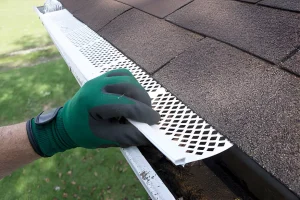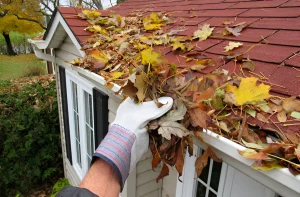When the rain begins to pour, your home’s defense against water damage is only as good as the condition of your eavestroughs and gutters. Regular maintenance and timely repairs are essential to ensuring that these crucial systems continue to protect your foundation, prevent landscaping damage, and avoid unwanted leaks.
In this guide, we’ll explore practical tips for repairing your eavestroughs and gutters, helping you tackle common issues from clogs and leaks to improper alignment. Whether you’re a seasoned DIYer or new to home maintenance, these insights will equip you to keep your drainage systems in top shape, safeguarding your home against the elements.
Here are some tips to help you with the repair process:
-
Regular Inspection:
Conduct regular inspections of your eavestroughs and gutters to identify any signs of damage or issues early on. Look for sagging, leaks, or loose fasteners.
-
Clean Debris:
Clear debris such as leaves, twigs, and dirt from the gutters. Clogged gutters can lead to water overflow and potential damage to the eavestroughs. Use gloves and a scoop for safe cleaning.
-
Check for Leaks:
During dry weather, check for leaks by running water through the gutters with a hose. This can help identify any holes or cracks that need sealing.
-
Secure Loose Fasteners:
Tighten or replace loose screws, bolts, or brackets holding the eavestroughs in place. Loose fasteners can contribute to sagging or misalignment.
-
Patch Small Holes:
If you notice small holes or cracks, use a waterproof sealant or gutter patching kit to seal them. Ensure the area is clean and dry before applying the patch.
-
Adjust Slope:
Eavestroughs should have a slight slope towards the downspouts for proper drainage. Adjust the slope if needed to prevent water pooling.
-
Install Splash Blocks:
Place splash blocks at the base of downspouts to direct water away from the foundation. This helps prevent soil erosion and potential foundation damage.
Replace Damaged Sections:
If a section of the eavestrough is severely damaged and cannot be repaired, consider replacing that section. This is often more cost-effective than extensive repairs.
-
Inspect Downspouts:
Check downspouts for clogs or obstructions. Use a plumber’s snake or a pressure washer to clear any debris that may be causing water to back up.
-
Reattach Hangers:
Ensure that hangers securing the eavestroughs to the fascia board are firmly in place. Reattach or replace any hangers that may have come loose.
-
Paint and Protect:
After repairs, consider applying a coat of rust-resistant paint to metal eavestroughs to protect them from the elements and extend their lifespan.
-
Consult Professionals:
For complex repairs or if you’re unsure about handling certain issues, it’s advisable to consult professional eavestrough and gutter repair services.
By following these tips and addressing issues promptly, you can maintain the functionality of your eavestroughs and gutters, protecting your home from potential water damage. Regular maintenance and timely repairs contribute to the longevity of the system.
Frequently Asked Questions (FAQ) – Tips for Repairing Eavestroughs and Gutters
Why is regular inspection important for eavestroughs and gutters?
Regular inspection helps identify potential issues early, preventing extensive damage and ensuring the proper functioning of the system.
How often should I clean debris from my gutters?
It’s recommended to clean debris from gutters at least twice a year, typically in the spring and fall. However, more frequent cleaning may be needed in areas with heavy foliage.
What should I use to patch small holes in eavestroughs?
Small holes can be patched using a waterproof sealant or a specialized gutter patching kit. Ensure the area is clean and dry before applying the patch.
How do I adjust the slope of my eavestroughs for proper drainage?
Adjust the slope by slightly lowering the end of the eavestrough that is farthest from the downspout. This allows water to flow towards the downspout.
When should I consider replacing a section of eavestrough rather than repairing it?
If a section is severely damaged and repairs would be extensive, it’s more cost-effective to replace that section. This is especially true for older or corroded eavestroughs.
How can I clear clogs in downspouts?
Use a plumber’s snake or a pressure washer to clear clogs (Effortless Ways To Unclog Gutters: Ladder-Free Solutions) in downspouts. Ensure the downspout is securely attached before attempting to clear the obstruction.
What is the purpose of splash blocks at the base of downspouts?
Splash blocks direct water away from the foundation, preventing soil erosion and potential damage to the foundation caused by concentrated water flow.
Is it necessary to paint metal eavestroughs after repairs?
Painting metal eavestroughs with rust-resistant paint after repairs helps protect them from the elements, extending their lifespan and preventing corrosion.
Can I handle eavestrough and gutter repairs on my own?
Many minor repairs can be handled by homeowners. However, for complex issues or if you’re unsure, it’s advisable to consult professional eavestrough and gutter repair services.
How can I ensure the longevity of my eavestrough system?
Regular maintenance, prompt repairs, and timely cleaning contribute to the longevity of eavestroughs and gutters, preventing issues that could lead to water damage.
Remember, safety is paramount when working on eavestroughs and gutters. If in doubt or if repairs seem challenging, seeking professional assistance is always a wise choice.





